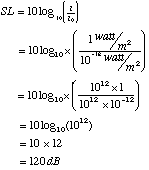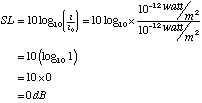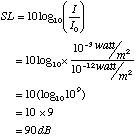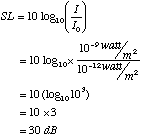10
Sound Intensity Level (SL)
These size-of-domain difficulties are avoided if we use a logarithmic scale based on a ratio of intensities. As it happens, we are normally more interested in comparing intensities than dealing with absolute values. This comparison is achieved by observing their ratio. For example, if the ratio of the intensities of two sounds is 3, one intensity is thrice that of the other.
Instead of specifying the power density (intensity) itself it is customary to
specify how many times the actual power is greater than the power of a reference-level
soundwave. This reference level is
10![]() Watt/m
Watt/m![]() . This is about
the weakest sound that humans can hear. The intensity of a sound above this reference
level is the Sound Intensity Level(SL) of the sound.
. This is about
the weakest sound that humans can hear. The intensity of a sound above this reference
level is the Sound Intensity Level(SL) of the sound.
If one sound has an intensity ![]() ( in Watt/m
( in Watt/m![]() ) and a second sound has an intensity
) and a second sound has an intensity ![]() , the second has an intensity relative to the first of
, the second has an intensity relative to the first of
![]() /
/![]() . The log
. The log![]() of this ratio gives us a value for the relationship,
the unit being the bel after Alexander Graham Bell, the inventor of
the telephone.
of this ratio gives us a value for the relationship,
the unit being the bel after Alexander Graham Bell, the inventor of
the telephone.
Definition: ![]()
The human audible range is then ![]() A still more practical unit of sound intensity level,
SL, that is used more widely today, is the tenth part of a bel, the decibel (dB).
A still more practical unit of sound intensity level,
SL, that is used more widely today, is the tenth part of a bel, the decibel (dB).
![]()
![]()
where ![]() =
10
=
10![]() Watt/m
Watt/m![]() , the intensity
at the threshold of hearing.
, the intensity
at the threshold of hearing. ![]() functions as a reference intensity - i.e. larger intensities are compared
to
functions as a reference intensity - i.e. larger intensities are compared
to ![]() through
the ratio
through
the ratio ![]() /
/![]() .
.
Calculation of some useful Sound Levels (SL's, in decibels)
1. Threshold of Feeling - SL of I = ![]()

N.B. The scale of SL's has been compressed from between 10![]() watt/m
watt/m![]() and 1 watt/m
and 1 watt/m![]() to between 0 and 120 dB - which is much more convenient.
to between 0 and 120 dB - which is much more convenient.
2. Threshold of Hearing - SL of I = 10![]() watt/m
watt/m![]()

3. "Fortissimo" - SL of I = 10![]() watt/m
watt/m![]()

4. "Pianissimo" - SL of I = 10![]() watt/m
watt/m![]()

5. Doubling The Sound Intensity Level
What is the change in SL when the intensity, I, is doubled?

Sound Intensity Level and Distance
If a sound is not reflected or interrupted, the intensity drops 6 dB ( i.e. 0.25 of its value) every time we double the distance. Thus, if the SL is 90 dB at 2 metres from the source, it will be 84 dB at 4 metres and 78 dB at 8 metres.